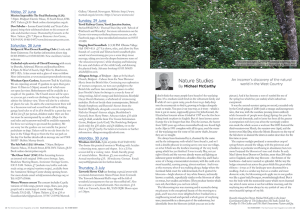
I don’t think that many people have heard of the wayfaring tree. It’s a medium-sized shrub in the virburnum family and while it’s not a great rarity, you do have to go fairly deep into the countryside to find it, growing in hedges alongside roads or tracks. You pass it on your way, as it were—which is how it got its name, supposedly given it by John Gerard, the Elizabethan botanist whose Herball of 1597 was the first best-selling book on plants in English. But it’s been known across Europe for a lot longer than that. Ötzi the iceman, the hunter from 5,000 years ago whose mummified body was found high in the Alps in 1991 complete with all his gear, used the stems of the wayfaring tree for some of his arrow shafts, because they are so straight.
I’ve always been fascinated by it, charmed by the name and by the infrequency with which I have found it, and so I took a double pleasure in coming across one near our village, on what I think was the loveliest morning of the very lovely spring which has just finished. It was in early May, not yet eight o’clock and the sun was already warm and lighting an iridescent green world from a cloudless blue sky, and I had a sense of it being a transcendent moment, with the earth at its most beautiful, seeming young, almost newborn. And it was at this moment, when I was walking along a hedge where the farmland fields meet the wild downland, that I spotted the blossoms—bright clusters of tiny white flowers, technically known as umbels, superficially similar to the blossom of elder or rowan, but smaller and whiter. (They produce berries which turn red, then black: you can’t eat either.)
The blossoming tree was stunning and it seemed to bring my pleasure in the exceptional beauty of the morning to a peak, and I was even more delighted when I walked into a neighbouring wood and spotted a whole grove of wayfaring trees, inaccessible in a dense part of the understorey, but identifiable from the blossoms (which you can see in the picture.) And it has become a sort of symbol for me of the spring has which has just ended, which indeed was exceptional.
It was the second-sunniest spring on record, exceeded only by the Covid spring of 2020 (such a strange and incongruous time, that was, with the sunshine pouring down endlessly while thousands of people were dying.) Spring this year has had no such downside, and its lustre has been all the greater in comparison with last year, when the seemingly-endless rain made the whole season a washout. But 2025 featured the third-sunniest-ever March, the sunniest-ever April, and the hottest-ever May Day, when the Morris Dancers on the top of the hill above us danced the dawn in under clear skies for the first time in years.
The copious sunlight produced a tremendous crop of spring flowers around the village, with the primroses and celandines in particular overflowing in abundance; but even more I enjoyed the blossom of trees and shrubs. In early May I drove from Dorset to Cheshire, more than 200 miles across England, and the may blossom—the flowers of the hawthorn—had never seemed so splendid. All the way the hedges streamed out across the green fields like great white ribbons—it was as if the landscape were decorated for a wedding. And in a similar way but on a smaller and more domestic scale, the blossoming crab apple tree in our garden was like a giant bridal bouquet, overwhelmingly floral. But it was the bush with the memorable name which most charmed me, when I came across it on that sublime morning, and the wayfaring tree will now always be my symbol of one of the most beautiful springs of my life.



